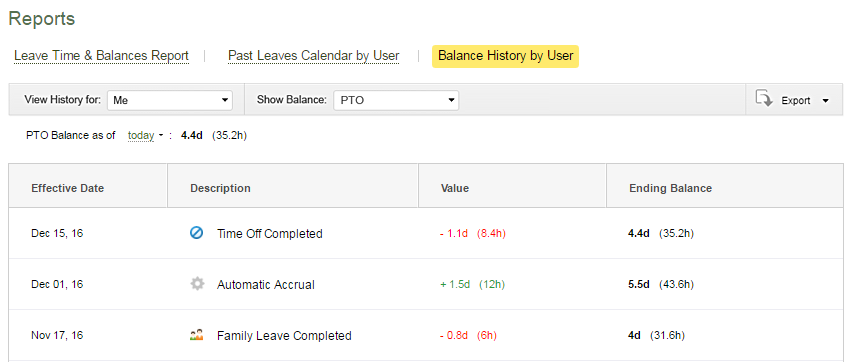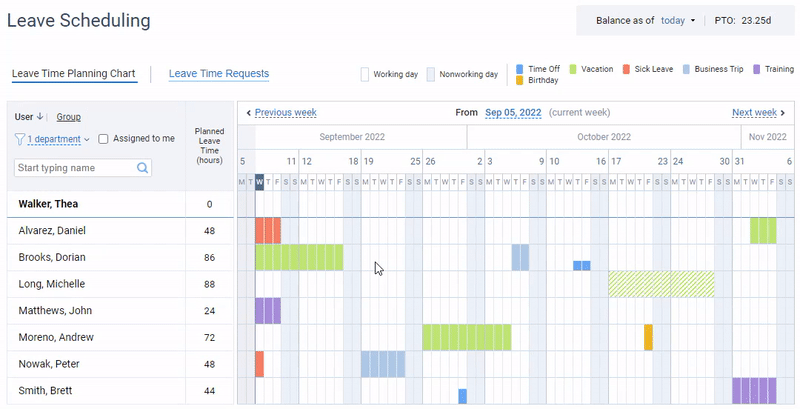Accurate leave accrual helps you comply with labor laws, boost employee satisfaction, and build trust in your relationships with employee. However, the accrual process is trickier than it seems at first glance.
You need to keep in mind a multitude of factors and variables, including leave types (sick, vacation, etc.), accrual rates, company policies, and employee-specific circumstances. All this can make calculations quite challenging.
That’s why we decided to dedicate this entire post to the subject of leave time accruals. We’ll go over some of the more common practices and suggest a few tips on how you can make your life a bit easier.
A Quick Introduction to Leave Accrual
Leave time accrual is the process of calculating the number of days or hours of paid leave time an employee earns while working at a company.
Leave accruals follow the same matching principle as any other type of accounting accrual in your business. It stipulates that “revenues should be recognized when earned and expenses should be matched at the same time as the recognition of revenue” (Jeff Schmidt for CFI).
Following this principle, you need to record employees’ leave at the time it’s earned, not when they actually go on vacation. In other words, your employees’ leave balances should grow steadily over time – way in advance of when they can actually take days off.
Key Factors to Consider
Accrual rate.
This is the speed at which an employee earns leave time. For example, if an hourly worker accrues 1 hour of vacation for every 40 work hours, their accrual rate is 0.025:
Accrual frequency.
This refers to how often leave time is accrued:
A yearly accrual rate is probably the easiest in terms of calculations and works excellent for long-term employees who have put in a year of tenure. With this rate, employees receive their entire yearly PTO allowance on their anniversary date or at the start of the year. And whenever they take a day off, you simply subtract it from their current balance.
Monthly and semi-monthly accruals mean your employees accrue paid leave time every month or every two weeks. These are some of the most commonly used and are also not very difficult to calculate – simply divide the total number of annual accrued leave days or hours by 12 for monthly accruals or 24 if you want your employees to earn PTO twice a month, and you’re pretty much good to go.
A daily leave accrual is when employees earn a certain amount of paid leave time for every day of work (it’s an excellent rate for part-time workers, but only for those who work full-day shifts). To calculate an employee’s accrued time under this rate, divide the total number of awarded PTO days per year (let’s say 20) by the total number of work days in a year:
Lastly, hourly accrual is unique because it does not guarantee a certain number of hours or days to accrue per year. Employees are only awarded leave time based on their hours, which works quite well for part-time workers with variable schedules.
With this rate, your part-timers will get less paid vacation time, while full-time employees who work overtime can earn more.
The calculations are still fairly straightforward – take the number of leave hours your employees would get per year if they worked a full schedule, let’s say 160 hours (or 20 days), then divide it by the total number of hours worked in a year (52 weeks x 40 hours = 2080 hours), and you’ll get the number of hours of PTO they’ll accrue for every hour of work:
What Is the Formula for Calculating Leave Accrual?
After employees’ accrual rates and frequency is decided upon, calculating their leave time balances is as easy as pie. The key formula goes as follows:
Let’s suppose your employee earns 2 leave hours bi-monthly, and they’ve worked for 3 months in a row. Here’s how to calculate their leave balance for this entire period:
Please note that in line with the matching principle, you must add the earned leave time to employees’ balances every 2 weeks (or at another preferred regular frequency) instead of calculating it all in bulk as shown in the example above. Then, updating your team members’ leave balances is just a matter of stacking up the earned leave balance over time or subtracting their used time off from the earned totals:
For example, if the same employee took a day off after 3 months of work, here’s how to calculate their leave balance for this entire period:
Still confused about how it all works?
Check out our free PTO balance calculator and automate the tedious accrual process with its help!
Simply enter your accrual rules (i.e., period, frequency, and rates) and press the button – the tool will provide you with a precise leave balance without much effort on your part.
Go ahead and test it out here – it is sure to help you better grasp how leave accruals function.
Additional Leave Accrual Formulas
Pro-rata leave
The term “pro-rata” is translated from Latin as “in proportion”. Based on this, pro-rata leave means the proportionate allocation of time off to employees in line with the amount of time they’ve invested in work.
Leave time is commonly pro-rated for part-time employees (as well as those who join or leave the company in the middle of the year). And to accrue pro-rated leave for part-timers, you can use the below formula:
Let’s say your full-time workers accrue 2 leave hours per 40 work hours, but your part-time employee works merely 30 hours a week. Then, they will earn the following amount of prorated leave time:
Time Off in Lieu (TOIL)
The term “in lieu” is translated from French as “instead of.” As for TOIL, it simply means time off instead of overtime pay.
In other words, you can reward employees for every overtime hour with leave time instead of money, and the amount of this leave time can be either proportionate to the overtime period one had or accrued at a different rate (e.g., one overtime hour = 1.5 TOIL hours).
So, if some of your team members have earned TOIL per accrual period, add it to their leave balance using the following formula:
For example, if an employee had 6 overtime hours within your bi-monthly leave accrual period, and you calculate TOIL at the 1.5 rate, the calculations will be as follows:
Laws Regulating Leave Accrual
Regulations surrounding PTO accrual can vary significantly from one country to another. We recommend employers to consult their local labor department or official state websites for detailed information on leave accrual regulations in a particular jurisdiction. However, here’s a quick overview:
European Union
In Europe, each country has its own specific regulations regarding annual leave entitlements for employees. However, there are some common principles that are followed across all EU members.
- Working Time Directive. The Working Time Directive is a European Union directive that sets out minimum requirements for working hours, rest periods, and annual leave. It stipulates that employees are entitled to at least four weeks (or twenty days) of paid annual leave per year.
- Collective agreements. In many European countries, collective agreements negotiated between employers and trade unions may also govern annual leave entitlements, including how leave accrual is calculated and any additional employee benefits.
The United States
In the United States, leave accrual is primarily regulated at the federal level by laws such as the Family and Medical Leave Act (FMLA) and the Fair Labor Standards Act (FLSA). These laws provide guidelines for leave entitlements, including unpaid leave for eligible employees.
In addition to federal laws, each state may have its own regulations regarding leave accrual. Some states have implemented their own family and medical leave laws that provide additional benefits beyond what is required by federal law. For example, states like California, New York, and Washington have their own paid family leave programs.
The United Kingdom
In the United Kingdom, all employees are entitled to a minimum of twenty-eight days of paid annual leave, including bank holidays. This entitlement is pro-rated for part-time employees. Employers in the UK must ensure that employees have the opportunity to take their full annual leave entitlement each year.
PTO accrual in the UK is straightforward, with employees typically accruing leave every month.
Australia
In Australia, employees are entitled to a minimum of twenty days of paid annual leave per year, pro-rated for part-time employees. Additionally, employees are entitled to 10 days of paid personal/carer’s leave and two days of unpaid carer’s leave per year.
PTO accrual in Australia is usually calculated based on the number of hours worked.
4 Ways to Calculate Leave Accrual: Pros & Cons
Manual leave accruals
Start by identifying the accrual rate, usually based on the number of hours worked or the length of employment. Then, multiply the accrual rate by the number of months worked to determine how much leave the employee has accrued.
For instance, if the accrual rate is 1 day per month and the employee has worked for 6 months, they would have accrued 6 days of leave.
Partly-automated Excel spreadsheets
Though manual calculations can be helpful for smaller organizations or when specific customization is required, calculating leave accrual using an Excel sheet can be more efficient.
Here’s how it works:
- Create columns for employee name, start date, accrued leave balance, leave taken, leave accrued per month, and any other relevant information.
- Enter the necessary employee data, such as their start date, current accrued leave balance, and the amount of leave they have taken.
- Set up formulas to calculate leave accrual. For example, if an employee accrues 1.5 days of leave per month, you can use a formula like “=AccruedLeaveBalance + 1.5” to calculate the new accrued leave balance each month.
You can set up Excel to automatically calculate leave accrual based on the start date and any other relevant factors or use a template to streamline your process.
Fully-automated PTO calculators
Excel provides a flexible way to manage and track employee leave balances. However, when you have a team of dozens or even hundreds of employees, keeping track of everything in a single Excel spreadsheet can become a nightmare.
Automated accrual calculators and leave management systems are designed to streamline and automate the tracking of employee leave balances, accruals, and requests for time off.
Unlike Excel spreadsheets, such tools are completely cloud-based and cannot be accidentally deleted or lost. Multiple people can access them simultaneously from anywhere at any time, as long as there’s an internet connection available.
Leave calculators typically use algorithms to calculate the amount of leave an employee is entitled to based on various factors such as the type of leave (sick leave, vacation leave, etc.), the employee’s start date, the company’s leave policy, and any accrued leave balances.
Users input relevant information such as the type of leave, the start and end dates, and any other relevant details, and the calculator processes this information to provide an accurate calculation of the leave entitlement.
Looking to try such a tool for free? Follow this link.
Multifunctional leave management software
Apart from the above, leave management systems provide valuable insights through data analytics, allowing HR managers to identify patterns and potential issues related to employee leave. They also help ensure compliance with labor laws, company policies, and union agreements by automating the enforcement of rules and regulations.
These systems maintain a real-time record of employee leave balances, approved leaves, and upcoming absences.
- Employees submit leave requests through the system, specifying the type of leave (sick leave, vacation, etc.), dates, and any other relevant information.
- The system routes the request to the appropriate manager or supervisor for approval. The workflow can be customized based on company policies.
- Automated notifications are sent to employees and managers at various stages of the approval process, keeping everyone informed and reducing delays.
- Managers generate reports on employee attendance, leave trends, and other relevant data to adjust PTO company policy and recruiting strategy.
Here’s an excellent example:
actiPLANS helps to streamline leave accrual calculations and save your lots of time and effort along the way! It combines flexible accrual rules and powerful automation with an intuitive leave request and approval procedures. This way, it simplifies the lives of both employees and managers, letting them keep track of accrued time off without a hitch.

With actiPLANS, you can set up rules for how leave is accrued based on factors such as length of employment, type of leave, and any other relevant criteria. Then, the system will calculate leave balances automatically, considering the set accrual rates, time off taken, and any adjustments made along the way.

Its leave scheduling interfaces have a truly convenient calendar view where team members can see who’s in and out of the office and plan their own time off with ease. Thanks to transparent and visual approach to leave management, actiPLANS helps your team prevent scheduling conflicts.

All in all, actiPLANS empowers you to save resources that would otherwise be spent on manual calculations leave accrual and tracking. It reduces the risk of errors multifold and turns leave management from a challenge into a child’s play.
Sign up for a free 30-day trial to test it out.
Conclusion
Hopefully, you get a better idea how to approach leave accruals after reading this post, and now you’re ready to apply a calculation method that suits your needs best.
If you’re running a micro-team and don’t mind to give your brain a little exercise, then go ahead and crunch the numbers manually. However, if you can’t stand doing math and have many team members at the workplace, then automated tools are a much better choice.
Using actiPLANS, you need to set the process merely once and the system will calculate and track everything for you. You can even automate the entire leave approval process and then just watch how our software handles all your leave management chores.
The best part is that actiPLANS has a free version for small teams and, even if your workforce is bigger, it’s still turns out super cheap to use as compared to other leave management systems on the market.
Still not ready to give it a try?
Then check out our PTO calculator! Although it requires you to input data manually for every employee, it automates leave accruals and boosts accuracy. Plus, it’s absolutely free to use. Give it a whirl here.




